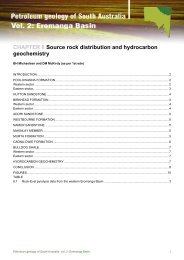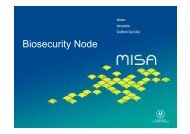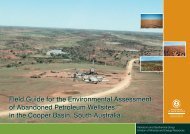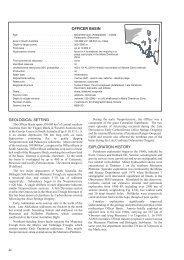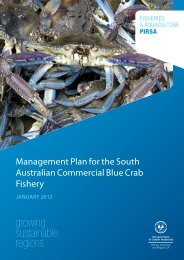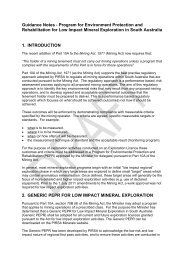Chapter 2: History of petroleum exploration and development - PIRSA
Chapter 2: History of petroleum exploration and development - PIRSA
Chapter 2: History of petroleum exploration and development - PIRSA
You also want an ePaper? Increase the reach of your titles
YUMPU automatically turns print PDFs into web optimized ePapers that Google loves.
Petroleum geology <strong>of</strong> South Australia. Vol. 4: Cooper Basin.Some non-local Aboriginal words <strong>and</strong> placenames havebeen used (e.g. Lowanna, Mina <strong>and</strong> Pooraka). Other namesare derived from animals (e.g. toolache, brumby <strong>and</strong>perenty), plants (e.g. boxwood, mulga, beanbush <strong>and</strong>correa), geological <strong>and</strong> geographical connections (e.g.Namur, Nealyon <strong>and</strong> regolith), prominent people or industryidentities (e.g. Sir George Grey, Sir Sidney Kidman, W.Paxton, Sir Douglas Mawson, J. Lhotsky <strong>and</strong> R.C. Sprigg)<strong>and</strong> an assortment <strong>of</strong> miscellaneous origin.ABORIGINES, LAND EXPLORATION ANDPASTORAL SETTLEMENT IN THE‘CORNER COUNTRY’Archaeological <strong>and</strong> anthropological evidence (e.g.Fenner, 1936), together with contemporary data <strong>and</strong> oraltraditions, have helped designate several Aboriginal groupsin the Eyre region <strong>and</strong> that it was an important trade <strong>and</strong>ceremonial centre (Fig. 2.2). Northeast South Australia <strong>and</strong>South-West Queensl<strong>and</strong> ‘is the driest part <strong>of</strong> Australia (<strong>and</strong>the only part without a seasonal pattern to its rainfall) <strong>and</strong>one <strong>of</strong> the warmest … The Aboriginal people … had alifestyle closely attuned to this most unpredictable <strong>of</strong>Australian environments. In good seasons large groupscould gather to harvest the food <strong>and</strong> hold ceremonies ... Inpoor seasons people lived in smaller groups, making use <strong>of</strong>the rare water sources such as mound springs <strong>and</strong> using skinwater-bags for travelling’ (Horton, 1994, p.350). LakeKopperamanna, ~70 km southeast <strong>of</strong> the Cooper Basin, wasa focal point for the distribution <strong>of</strong> pituri (a narcotic) fromnorthern Australia, stone for artefacts from the east <strong>and</strong> west,<strong>and</strong> pigments, particularly ochre from the Flinders Ranges,from the south.The principal group associated with the region is theDieri tribe (alternatively Diyari, Diyeri or Diari), fringedesert <strong>and</strong> desert peoples who have occupied l<strong>and</strong> east <strong>of</strong>Lake Eyre <strong>and</strong> along the lower Cooper Creek towards theState border. There may be clans within the Dieri tribeaccording to regional affiliations: Berndt <strong>and</strong> Vogelsang(1939) divided the tribe into Ku´nari (Cooper Creek Dieri)98-1106ArrernteNorthern TerritoryArabanaWangkangurru(South)Kokatha0 100KILOMETRESLakeEyre(North)DhirariKuyaniQueensl<strong>and</strong>WangkamanaYarluy<strong>and</strong>iKaruwaliKaranguraNgaminiLIMIT OFCOOPER BASINDieriAndyamathanhaYawarawarkaWangkumaraY<strong>and</strong>ruw<strong>and</strong>haPirlatapaWadigaliMalyangabaBirriaNew South WalesFig. 2.2 Tribal groupings <strong>of</strong> Aborigines in the Eyre regionextending from the northeast <strong>of</strong> South Australia (after Horton,1994).<strong>and</strong> O<strong>and</strong>u (Lake Hope Dieri). The Dieri’s neighboursinclude the Dhirari (or Thirrari) people adjoining Lake Eyre,whose country ‘was the southernmost point known to havebeen reached by pearl shell in its extraordinary trade fromCape York’ (Horton, 1994, p.278); the Ngamini people onthe Warburton Creek <strong>and</strong> Diamantina River, whose majormeeting place for trade <strong>and</strong> ceremonies was Goyder’sLagoon north <strong>of</strong> Lake Eyre (Horton, 1994, p.780); <strong>and</strong> theYawarawarka people who attended big corroborees at AnnaCreek, west <strong>of</strong> Lake Eyre (Horton, 1994, p.1221) althoughtheir area extended beyond South Australia.In European times the area where South Australia, NewSouth Wales <strong>and</strong> Queensl<strong>and</strong> meet has been known as the‘Corner Country’. Early explorers associated with the areainclude: E.J. Eyre who travelled in 1840 south <strong>of</strong> LakeBlanche <strong>and</strong> through Dhirari country to the southern <strong>of</strong> thetwo lakes which bear his name (Eyre, 1845; Manning,1990); Captain C. Sturt in 1844–45; A.C. Gregory who camesouth from Queensl<strong>and</strong> to the east <strong>of</strong> Lake Blanche whilesearching for the missing explorer L. Leichhardt in 1858;R.O’H. Burke <strong>and</strong> W.J. Wills, who crossed the continentfrom Melbourne in the south to the Gulf <strong>of</strong> Carpentaria in thenorth, in 1860–61; <strong>and</strong> J. McKinlay <strong>and</strong> A.W. Howitt,leaders <strong>of</strong> search parties for Burke <strong>and</strong> Wills in 1861.Howitt made other journeys in the area. J.McD. Stuart, whohad accompanied Sturt as a draftsman <strong>and</strong> whoseexpeditions to <strong>and</strong> across the centre <strong>of</strong> the continent in1860–63 rivalled that <strong>of</strong> Burke <strong>and</strong> Wills without thecatastrophic consequences, also made two trips west <strong>of</strong> LakeEyre in 1858 <strong>and</strong> 1859 in the proximity <strong>of</strong> Dhirari country.In 1863 S. White traversed an area from Lake Blanche toCooper Creek <strong>and</strong> Lake Hope while recording bird life incentral Australia. Major P.E. Warburton explored forpossible stock routes northeast from Lake Eyre alongCooper Creek in 1866. J. Lewis also ventured along CooperCreek in 1874–75 while leading a government party north<strong>and</strong> east <strong>of</strong> Lake Eyre to see the extent to which it could benavigated.On his journey from Adelaide to discover the fabledinl<strong>and</strong> sea in central Australia, Sturt named the Great StonyDesert (now the Sturt Stony Desert), Strzelecki Creek afterthe Prussian-born Polish scientist <strong>and</strong> explorer P.E. deStrzelecki who had explored southeastern Australia, <strong>and</strong>‘Cooper’s Creek’ after South Australia’s Chief Justice, SirCharles Cooper. The latter was named in November 1845,three months after Sturt first discovered it, during whichtime he crossed it several times <strong>and</strong> confirmed that it was thesame river. Ten months later the New South WalesSurveyor-General, Major Sir Thomas Mitchell, anothernoted explorer, named the northeastern reaches <strong>of</strong> Cooper’sCreek, Victoria River, in honour <strong>of</strong> Queen Victoria(Mitchell, 1848). Gregory’s expedition in 1858 showed theywere the same river: from Sydney he had gone toQueensl<strong>and</strong> <strong>and</strong> ventured south along the upper Cooper <strong>and</strong>down Strzelecki Creek. Consequently, from May 1861 anAboriginal name, Barcoo, was adopted <strong>of</strong>ficially. By themid 1930s it was accepted that an Aboriginal name could notapply to the whole river <strong>and</strong> Barcoo was being consideredarchaic (Parker <strong>and</strong> Somerville, 1943). A local Aboriginalname for Cooper Creek was Kunadi (Mattingley <strong>and</strong>Hampton, 1988), Ku´nari (Berndt <strong>and</strong> Vogelsang, 1939) orKunara (Johnston <strong>and</strong> Clel<strong>and</strong>, 1943). From 1944 Cooper8










